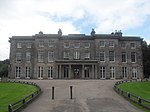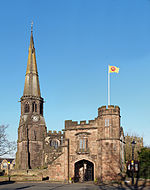Church in Greater Manchester, England
| St Michael and All Angels' Church, Howe Bridge | |
|---|---|
 St Michael and All Angels' Church, Howe Bridge, from the east St Michael and All Angels' Church, Howe Bridge, from the east | |
 Howe BridgeLocation in Greater Manchester | |
| 53°31′03″N 2°30′25″W / 53.5176°N 2.5069°W / 53.5176; -2.5069 | |
| OS grid reference | SD 665,025 |
| Location | Leigh Road, Howe Bridge, Atherton, Greater Manchester |
| Country | England |
| Denomination | Anglican |
| Website | Parish Website |
| History | |
| Status | Parish church |
| Consecrated | 7 February 1877 |
| Architecture | |
| Functional status | Active |
| Heritage designation | Grade II* |
| Designated | 31 July 1996 |
| Architect(s) | Paley and Austin, Austin and Paley |
| Architectural type | Church |
| Style | Gothic Revival |
| Groundbreaking | 1875 |
| Completed | 1877 |
| Specifications | |
| Materials | Sandstone with tiled roofs |
| Administration | |
| Province | York |
| Diocese | Manchester |
| Archdeaconry | Salford |
| Deanery | Leigh |
| Parish | St Michael and All Angels, Howe Bridge |
| Laity | |
| Reader(s) | Cath Baines |
St Michael and All Angels' Church is in Leigh Road, Howe Bridge, a suburb of Atherton, Greater Manchester, England. It is an active Anglican parish church in the deanery of Leigh, the archdeaconry of Salford and the diocese of Manchester. Its benefice is united with those of three local churches, St John the Baptist, St George and St Philip, forming a team ministry entitled the United Benefice of Atherton and Hindsford with Howe Bridge. The church is recorded in the National Heritage List for England as a designated Grade II* listed building.
History
The church was built between 1875 and 1877 to a design by the Lancaster architects Paley and Austin for Fletcher, Burrows and Company, the owners of three collieries in Atherton. It cost £7,000 (equivalent to £830,000 in 2023), and was paid for by Ralph Fletcher. The church was consecrated on 7 February 1877, and became a separate parish in its own right in August 1878. In 1928 the church was reseated at a cost of £1,056 by Austin and Paley, the successors in the Lancaster practice, and in 1938 they added a vestry at the east end at a cost of £1,338. The United Benefice was created in 2002.
Architecture
Exterior
St Michael's is constructed in coursed stone with dressings of Runcorn red sandstone ashlar, and has tiled roofs. Its plan is cruciform, consisting of an aisleless nave with a north porch and side chapels, north and south transepts, and a chancel with a clerestory and aisles, and an attached meeting room and choir vestry. Above the crossing is a two-stage octagonal flèche surmounted by a tall spire. At the west end is a large central buttress flanked by two-light windows with pointed arches. Above these in the gable are three small lancet windows. On the north side of the church is a timber-framed porch with a gable and side windows. To the east of this is a single two-light window and two three-light windows. There are similar windows on the south side of the nave. The chapels have two-light windows on the west and three-light windows on their sides. The transept gables contain a three-light window flanked by buttresses, and two lancets above them. In the clerestory there are three small lancet windows on each side. The large east window consists of five stepped lancets. There are further lancet windows in the rooms adjoining the chancel. Against the north wall of the chancel is a gabled stair turret decorated with blind arcading.
Interior
The nave has an open roof, and the chancel is stone-vaulted. The arcades in the chancel are carried on round and cluster piers, and have double-chamfered arches. The reredos is in marble and dates from 1903. The choir stalls date from 1919 and are in Perpendicular style. The chapel screens are in Decorated style. The chancel screen and the pulpit date from 1919 and are in wrought and cast iron. The font consists of a marble drum with panels. Much of the stained glass is by C. E. Kempe, dating from 1896 and other dates. There is a window in the north transept dated 1922 by Edward Moore. Also in the church are memorials, most of which are to the Fletcher family. The three-manual organ was made in 1932 by Rushworth and Dreaper of Liverpool.
Present day
The church was listed at Grade II* on 31 July 1996. Grade II* is the middle of the three gradings given by English Heritage, and is granted to buildings that "are particularly important buildings of more than special interest". Commenting on its design, the architectural historians Richard Pollard and Nikolaus Pevsner in the Buildings of England series say of the architects that "it is one of their most stimulating churches".
The church arranges regular services on Sundays and during the week. It has a choir and a Mothers' Union, and runs a Sunday School, Scouts, Guides and associated groups.
See also
- Grade II* listed buildings in Greater Manchester
- Listed buildings in Atherton, Greater Manchester
- List of churches in Greater Manchester
- List of ecclesiastical works by Paley and Austin
References
- St Michael & All Angels, Howe Bridge, Church of England, retrieved 28 August 2011
- ^ Historic England, "Church of St Michael and All Angels, Howe Bridge (1268288)", National Heritage List for England, retrieved 28 August 2011
- UK Retail Price Index inflation figures are based on data from Clark, Gregory (2017), "The Annual RPI and Average Earnings for Britain, 1209 to Present (New Series)", MeasuringWorth, retrieved 7 May 2024
- Brandwood et al. 2012, pp. 107, 229.
- ^ Howe Bridge St Michael and All Angels, Lancashire OnLine Parish Clerks, retrieved 28 August 2011
- Brandwood et al. 2012, p. 251.
- Brandwood et al. 2012, p. 255.
- ^ Pollard & Pevsner 2006, pp. 141–142.
- Brandwood et al. 2012, p. 107.
- "NPOR [N00546]", National Pipe Organ Register, British Institute of Organ Studies, retrieved 1 July 2020
- Listed buildings, Historic England, retrieved 9 April 2015
- St Michael's, Atherton Team Ministry, retrieved 28 August 2011
Bibliography
- Brandwood, Geoff; Austin, Tim; Hughes, John; Price, James (2012), The Architecture of Sharpe, Paley and Austin, Swindon: English Heritage, ISBN 978-1-84802-049-8
- Pollard, Richard; Pevsner, Nikolaus (2006), Lancashire: Liverpool and the South-West, The Buildings of England, New Haven and London: Yale University Press, ISBN 0-300-10910-5
| Churches in the Deanery of Salford and Leigh | |
|---|---|
| Benefice of Astley | |
| Benefice of Atherton |
|
| Benefice of Barton |
|
| Benefice of Bedford Leigh |
|
| Benefice of Broughton |
|
| Benefice of Cadishead |
|
| Benefice of Clifton |
|
| Benefice of Eccles |
|
| Benefice of Hope and Pendlebury |
|
| Benefice of Irlam |
|
| Benefice of Kersal Moor |
|
| Benefice of Leigh St Mary | |
| Benefice of Lower Broughton | |
| Benefice of Ordsall and Salford Quays | |
| Benefice of Pennington | |
| Benefice of Salford All Saints |
|
| Benefice of Salford Sacred Trinity |
|
| Benefice of Salford St Paul |
|
| Benefice of Salford St Philip | |
| Benefice of Swinton and Pendlebury |
|
| Benefice of Swinton Holy Rood |
|
| Benefice of Walkden and Little Hulton |
|
| Benefice of Westleigh |
|
| Benefice of Worsley |
|
- Grade II* listed churches in Greater Manchester
- Church of England church buildings in Greater Manchester
- Anglican Diocese of Manchester
- Churches completed in 1877
- 19th-century Church of England church buildings
- Gothic Revival church buildings in England
- Gothic Revival architecture in Greater Manchester
- Paley and Austin buildings
- Austin and Paley buildings
- Atherton, Greater Manchester
- 1877 establishments in England


